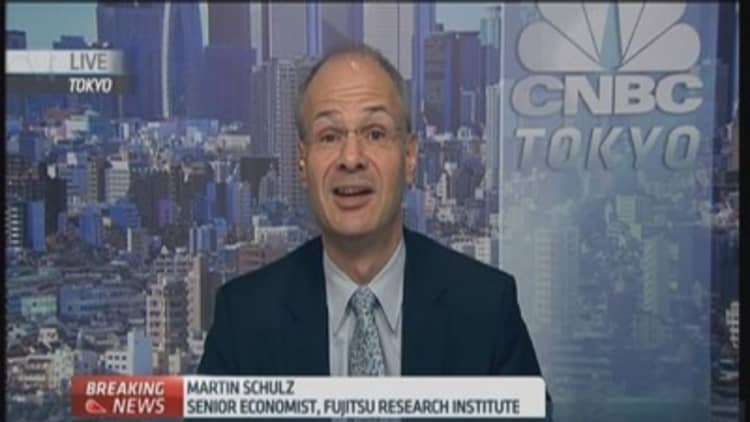
Japan's industrial production rose at its fastest pace since the beginning of the year in September, data showed on Wednesday.
Industrial production rose 2.7 percent on month, above expectations for a 2.2 percent rise and up from a 1.9 percent decline in August, marking the fastest expansion since January.
Following the release the Japanese government said that industrial production is "seesawing."
Read MoreWhy Japan's economy is stuck in 'no man's land'
"[This trend of seesawing] is clearly what we see, but today's data is strong... Overall on a month-on-month basis, retailers and producers are up. We're seeing now that production is picking up as well," said Martin Schulz, Senior Economist at Fujitsu Research Institute.
Japanese manufacturers see October output down 0.1 percent on month, slightly better than their previous forecast for a 0.2 percent decline, according to the Ministry of Economy, Trade and Industry. Manufacturers see November output rising 1.0 percent on month.
"The destocking process is likely to keep [industrial production] weak in the near term. Although September figures show a sign for recovery... relatively high inventory levels remain a concern, especially for transportation equipment and general-purpose, production and business oriented machinery," Harumi Taguchi, principal economist at IHS Global Insight said in a note.
"The industry outlook also suggests a moderate uptrend," she said. "If production matches this outlook and holds at November level in December, quarter-on-quarter growth for the fourth quarter is expected to rise by 1.3 percent after two consecutive quarters of declines."
Read MoreJapanese exports grow at fastest pace in 7 months
In April, the government raised the consumption tax to 8 percent from 5 percent to rein in the country's budget-to-GDP ratio. It was the first tax hike in 17 years.
"Domestic demand is gradually bottoming out and overall, household sentiment and demand haven't dropped as much as everyone expected after the sales tax hike," Schulz added. "The most important driving force is now exports, which are significantly up [and that] seems to be turning into a trend. Producers are optimistic and weak yen is finally helping."
"People are looking at the Japanese economy to recover after the sales tax hike and today's data suggests that maybe it has come later than expected, but it's starting to come through quite nicely. So we are quite optimistic on the outlook for Japan," said Steve Brice, Chief Investment Strategist, Standard Chartered Wealth Management Group.
Analysts have said the performance of Japan's economy over the third quarter will likely determine whether the government proceeds with a second tax hike to 10 percent in 2015.
Read MoreJapan retail sales rise at fastest pace since Q1 in September
However, some politicians want this plan to be delayed. On Monday, a top Japanese government official said, on condition of anonymity, that Prime Minister Shinzo Abe should delay a second tax hike until April 2017, Reuters reported.
Japan's Nikkei index opened 0.6 percent higher shortly after the data was released.


